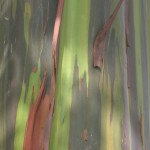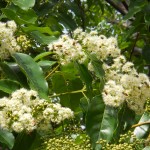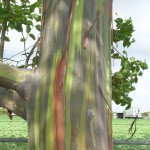Eucalyptus deglupta (Rainbow Eucalyptus)
There are almost 900 Eucalyptus species in the world! Some are gigantic and others dwarf; some are water-tolerant and others xeric, but only one of them is native to the northern hemisphere. That species is Eucalyptus deglupta, the Rainbow Eucalyptus. It is found on various Pacific islands, including Mindanao (Philippines), Seram (Indonesia), Sulawesi (Indonesia), New Guinea (Indonesia and Papua New Guinea), and New Britain (Papua New Guinea). It is the only Eucalyptus adapted to lowland and lower montane rainforest habitats, and it is one of only four species not endemic to Australia.
For the record, E. deglupta normally develops a pyramidal crown, but it is the trunk that attracts attention. The Rainbow Eucalyptus is so-named because of its beautiful exfoliating bark, which simultaneously exhibits a vast range of colors — light green, dark green, gray, pink, red, orange, blue, purple, maroon. A photo at the top of this webpage provides a good idea of the splendor of this species. It occurs naturally in dense riverside stands, where deep, sandy soils and rainfall of 100-200 in. a year promote a high-octane growth rate. In fact, it is probably the fastest-growing forestry tree in the world, reaching heights well over 200 ft. in ideal settings. But the tree is much more manageable in southern Florida. Although E. deglupta is quite adaptable to limestone-derived soils, the shallowness of our soils, as well as average rainfall here of less than 60 in. a year, limits mature height to about 60 ft. The species is not frost-hardy, but can handle the upper 20s for brief periods.
This species is not just another pretty face. While its wood is not extremely dense, it is of sufficient quality to render it useful for a number of construction purposes, and beginning about 95 years ago plantations have been installed pantropically to produce pulpwood that yields a very bright white paper.
In locating a Rainbow Eucalyptus on your property, follow the criterion used for avocados: Plant the tree away from the house, so that limb breakage during storms will cause minimal damage. E. deglupta can be found here at the nursery in 3-gal. and 15-gal. sizes. We recommend that you not keep this species containerized indefinitely, because it doesn’t happily tolerate lapses in watering.


